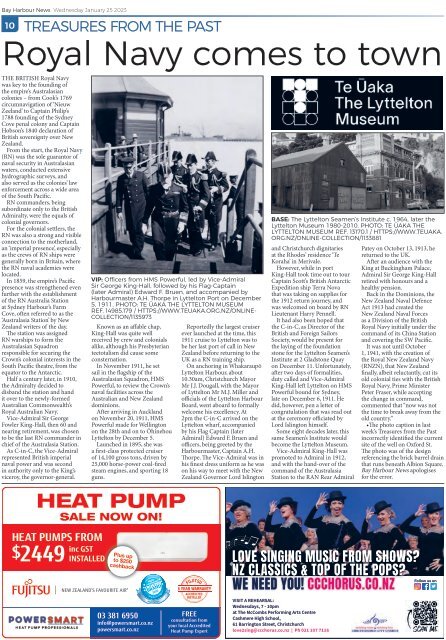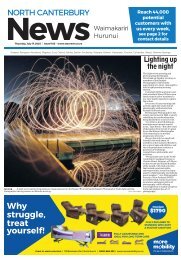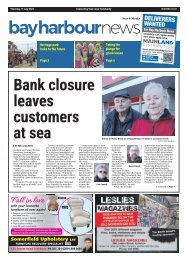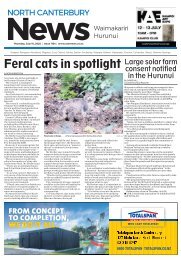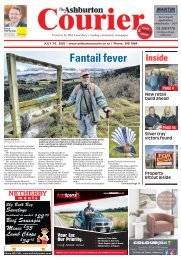Bay Harbour: January 25, 2023
Transform your PDFs into Flipbooks and boost your revenue!
Leverage SEO-optimized Flipbooks, powerful backlinks, and multimedia content to professionally showcase your products and significantly increase your reach.
Social icon<br />
Rounded square<br />
Only use blue and/or white.<br />
For more details check out our<br />
Brand Guidelines.<br />
<strong>Bay</strong> <strong>Harbour</strong> News Wednesday <strong>January</strong> <strong>25</strong> <strong>2023</strong><br />
10<br />
TREASURES FROM THE PAST<br />
Royal Navy comes to town<br />
THE BRITISH Royal Navy<br />
was key to the founding of<br />
the empire’s Australasian<br />
colonies – from Cook’s 1769<br />
circumnavigation of ‘Nieuw<br />
Zeeland’ to Captain Philip’s<br />
1788 founding of the Sydney<br />
Cove penal colony and Captain<br />
Hobson’s 1840 declaration of<br />
British sovereignty over New<br />
Zealand.<br />
From the start, the Royal Navy<br />
(RN) was the sole guarantor of<br />
naval security in Australasian<br />
waters, conducted extensive<br />
hydrographic surveys, and<br />
also served as the colonies’ law<br />
enforcement across a wide area<br />
of the South Pacific.<br />
RN commanders, being<br />
subordinate only to the British<br />
Admiralty, were the equals of<br />
colonial governors.<br />
For the colonial settlers, the<br />
RN was also a strong and visible<br />
connection to the motherland,<br />
an ‘imperial presence’, especially<br />
as the crews of RN ships were<br />
generally born in Britain, where<br />
the RN naval academies were<br />
located.<br />
In 1859, the empire’s Pacific<br />
presence was strengthened even<br />
further with the establishment<br />
of the RN Australia Station<br />
at Sydney <strong>Harbour</strong>’s Farm<br />
Cove, often referred to as the<br />
‘Australasia Station’ by New<br />
Zealand writers of the day.<br />
The station was assigned<br />
RN warships to form the<br />
Australasian Squadron<br />
responsible for securing the<br />
Crown’s colonial interests in the<br />
South Pacific theatre, from the<br />
equator to the Antarctic.<br />
Half a century later, in 1910,<br />
the Admiralty decided to<br />
disband the station and hand<br />
it over to the newly-formed<br />
Australian Commonwealth’s<br />
Royal Australian Navy.<br />
Vice-Admiral Sir George<br />
Fowler King-Hall, then 60 and<br />
nearing retirement, was chosen<br />
to be the last RN commander in<br />
chief of the Australasia Station.<br />
As C-in-C, the Vice-Admiral<br />
represented British imperial<br />
naval power and was second<br />
in authority only to the King’s<br />
viceroy, the governor-general.<br />
VIP: Officers from HMS Powerful, led by Vice-Admiral<br />
Sir George King-Hall, followed by his Flag-Captain<br />
(later Admiral) Edward F. Bruen, and accompanied by<br />
<strong>Harbour</strong>master A.H. Thorpe in Lyttelton Port on December<br />
5, 1911. PHOTO: TE ŪAKA THE LYTTELTON MUSEUM<br />
REF. 14985.179 / HTTPS://WWW.TEUAKA.ORG.NZ/ONLINE-<br />
COLLECTION/1135973<br />
Known as an affable chap,<br />
King-Hall was quite well<br />
received by crew and colonials<br />
alike, although his Presbyterian<br />
teetotalism did cause some<br />
consternation.<br />
In November 1911, he set<br />
sail in the flagship of the<br />
Australasian Squadron, HMS<br />
Powerful, to review the Crown’s<br />
naval facilities across the<br />
Australian and New Zealand<br />
dominions.<br />
After arriving in Auckland<br />
on November 20, 1911, HMS<br />
Powerful made for Wellington<br />
on the 28th and on to Ōhinehou<br />
Lyttelton by December 5.<br />
Launched in 1895, she was<br />
a first-class protected cruiser<br />
of 14,100 gross tons, driven by<br />
<strong>25</strong>,000 horse-power coal-fired<br />
steam engines, and sporting 18<br />
guns.<br />
HEAT PUMP<br />
SALE NOW ON!<br />
Reportedly the largest cruiser<br />
ever launched at the time, this<br />
1911 cruise to Lyttelton was to<br />
be her last port of call in New<br />
Zealand before returning to the<br />
UK as a RN training ship.<br />
On anchoring in Whakaraupō<br />
Lyttelton <strong>Harbour</strong>, about<br />
10.30am, Christchurch Mayor<br />
Mr J.J. Dougall, with the Mayor<br />
of Lyttelton Mr M.J. Miller and<br />
officials of the Lyttelton <strong>Harbour</strong><br />
Board, went aboard to formally<br />
welcome his excellency. At<br />
2pm the C-in-C arrived on the<br />
Lyttelton wharf, accompanied<br />
by his Flag Captain (later<br />
Admiral) Edward F. Bruen and<br />
officers, being greeted by the<br />
<strong>Harbour</strong>master, Captain A.H.<br />
Thorpe. The Vice-Admiral was in<br />
his finest dress uniform as he was<br />
on his way to meet with the New<br />
Zealand Governor Lord Islington<br />
BASE: The Lyttelton Seamen’s Institute c. 1964, later the<br />
Lyttelton Museum 1980-2010. PHOTO: TE ŪAKA THE<br />
LYTTELTON MUSEUM REF. 13170.1 / HTTPS://WWW.TEUAKA.<br />
ORG.NZ/ONLINE-COLLECTION/1133881<br />
and Christchurch dignitaries<br />
at the Rhodes’ residence ‘Te<br />
Koraha’ in Merivale.<br />
However, while in port<br />
King-Hall took time out to tour<br />
Captain Scott’s British Antarctic<br />
Expedition ship Terra Nova<br />
that was taking on supplies for<br />
the 1912 return journey, and<br />
was welcomed on board by RN<br />
Lieutenant Harry Pennell.<br />
It had also been hoped that<br />
the C-in-C, as Director of the<br />
British and Foreign Sailors<br />
Society, would be present for<br />
the laying of the foundation<br />
stone for the Lyttelton Seamen’s<br />
Institute at 2 Gladstone Quay<br />
on December 11. Unfortunately,<br />
after two days of formalities,<br />
duty called and Vice-Admiral<br />
King-Hall left Lyttelton on HMS<br />
Powerful bound for Sydney,<br />
late on December 6, 1911. He<br />
did, however, pen a letter of<br />
congratulation that was read out<br />
at the ceremony officiated by<br />
Lord Islington himself.<br />
Some eight decades later, this<br />
same Seamen’s Institute would<br />
become the Lyttelton Museum.<br />
Vice-Admiral King-Hall was<br />
promoted to Admiral in 1912,<br />
and with the hand-over of the<br />
command of the Australasia<br />
Station to the RAN Rear Admiral<br />
Patey on October 13, 1913, he<br />
returned to the UK.<br />
After an audience with the<br />
King at Buckingham Palace,<br />
Admiral Sir George King-Hall<br />
retired with honours and a<br />
healthy pension.<br />
Back in the Dominions, the<br />
New Zealand Naval Defence<br />
Act 1913 had created the<br />
New Zealand Naval Forces<br />
as a Division of the British<br />
Royal Navy initially under the<br />
command of its China Station<br />
and covering the SW Pacific.<br />
It was not until October<br />
1, 1941, with the creation of<br />
the Royal New Zealand Navy<br />
(RNZN), that New Zealand<br />
finally, albeit reluctantly, cut its<br />
old colonial ties with the British<br />
Royal Navy. Prime Minister<br />
Peter Fraser, while accepting<br />
the change in command,<br />
commented that “now was not<br />
the time to break away from the<br />
old country.”<br />
•The photo caption in last<br />
week’s Treasures from the Past<br />
incorrectly identified the current<br />
site of the well on Oxford St.<br />
The photo was of the design<br />
referencing the brick barrel drain<br />
that runs beneath Albion Square.<br />
<strong>Bay</strong> <strong>Harbour</strong> News apologises<br />
for the error.<br />
Plus up<br />
to $<strong>25</strong>0<br />
cashback<br />
2022<br />
Heat Pumps


